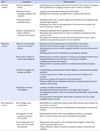Abstract
Purpose
The purpose of this study was to explore psychiatric nurses' decision making in the use of seclusion and
restraint (SR).
Methods
Data were collected using focus group interviews. Two focus group interviews were held with a total of 10 psychiatric nurse participants. All interviews were recorded and transcribed, and data were analyzed using qualitative content analysis.
Results
Eleven categories emerged from three main themes. All the themes describe factors that participants took into account when deciding whether to implement SR: 1) Personal factors area: ‘Personal attributes of nurses,’ ‘Attitude of nurses regarding SR,’ ‘Nurses’ ‘physical and emotional states,’ ‘Negative experiences of nurses related to SR’; 2) Relational factors area: ‘The level of cooperation between nurses and doctors,’ ‘Role models created by seniors and colleagues,’ ‘The level of support by nursing assistants,’ ‘Therapeutic relations with patients’; and 3) Environmental factors area: ‘Poor nursing work environment,’ ‘Atmosphere of ward regarding SR,’ and ‘Social atmosphere to raise alarm about SR.’
Figures and Tables
References
1. Perkins E, Prosser H, Riley D, Whittington R. Physical restraint in a therapeutic setting: a necessary evil? International Journal of Law and Psychiatry. 2012; 35(1):43–49. DOI: 10.1016/j.ijlp.2011.11.008.

2. National Human Rights Commission of Korea. Survey of seclusion and restraint in psychiatric hospital. Seoul: National Human Rights Commission of Korea;2015. 11. Report No. 11-1620000-000587-01.
3. National Human Rights Commission of Korea. National reports for mental disabilities the protection of human rights and the promotion. Seoul: National Human Rights Commission of Korea;2009. 11. Report No. 11-1620000-000184-01.
4. Smith GM, Davis RH, Bixler EO, Lin HM, Altenor A, Altenor RJ, et al. Pennsylvania State Hospital system's seclusion and restraint reduction program. Psychiatric Services. 2005; 56(9):1115–1122. DOI: 10.1176/appi.ps.56.9.1115.

5. Larue C, Dumais A, Ahern E, Bernheim E, Mailhot MP. Factors influencing decisions on seclusion and restraint. Journal of Psychiatric and Mental Health Nursing. 2009; 16(5):440–446. DOI: 10.1111/j.1365-2850.2009.01396.x.

6. Riahi S, Thomson G, Duxbury J. An integrative review exploring decision-making factors influencing mental health nurses in the use of restraint. Journal of Psychiatric and Mental Health Nursing. 2016; 23(2):116–128. DOI: 10.1111/jpm.12285.

7. Jin J, Yoo JH. Psychiatric patients' experiences of being restrained: a phenomenological study. Journal of Korean Academy of Psychiatric and Mental Health Nursing. 2013; 22(4):349–358. DOI: 10.12934/jkpmhn.2013.22.4.349.

8. Lim MH. Practice of psychiatry ethics in the clinical applications. Korean Journal of Medical Ethics. 2015; 18(1):36–49.

9. Campos DCF, Graveto JMGN. The role of nurses and patients' involvement in the clinical decision-making process. Revista Latino-Americana De Enfermagem. 2009; 17(6):1065–1070. DOI: 10.1590/s0104-11692009000600021.

10. Laiho T, Kattainen E, Åstedt-Kurki P, Putkonen H, Lindberg N, Kylmä J. Clinical decision making involved in secluding and restraining an adult psychiatric patient: an integrative literature review. Journal of Psychiatric and Mental Health Nursing. 2013; 20(9):830–839. DOI: 10.1111/jpm.12033.

11. An HJ, Kim EH, Chung YH, An JS, Cho WA, Park JH. A study about restraint use in care of patients with psychiatric disorders. Journal of Korean Clinical Nursing Research. 2013; 19(3):432–442.
12. Larue C, Piat M, Racine H, Ménard G, Goulet MH. The nursing decision making process in seclusion episodes in a psychiatric facility. Issues in Mental Health Nursing. 2010; 31(3):208–215. DOI: 10.3109/01612840903131800.

13. Huckshorn KA. Reflections on the use of restraint and seclusion: a 10-year update. Journal of Psychosocial Nursing & Mental Health Services. 2014; 52(11):3–4. DOI: 10.3928/02793695-20140930-01.

14. Raboch J, Kališová L, Nawka A, Kitzlerová E, Onchev G, Karastergiou A, et al. Use of coercive measures during involuntary hospitalization: findings from ten european countries. Psychiatric Services. 2010; 61(10):1012–1017. DOI: 10.1176/ps.2010.61.10.1012.

15. Morgan DL. Focus groups. Annual Review of Sociology. 1996; 22:129–152. DOI: 10.1146/annurev.soc.22.1.129.

16. Kim HJ, Kim CN. Review of literatures on focus group method in qualitative study. Keimyung Journal of Nursing Science. 2001; 5(1):1–21.
17. Hsieh HF, Shannon SE. Three approaches to qualitative content analysis. Qualitative Health Research. 2005; 15(9):1277–1288. DOI: 10.1177/1049732305276687.

18. Sandelowski M. The problem of rigor in qualitative research. Advances in Nursing Science. 1986; 8(3):27–37. DOI: 10.1097/00012272-198604000-00005.

19. Bigwood S, Crowe M. ‘It's part of the job, but it spoils the job’: a phenomenological study of physical restraint. International Journal of Mental Health Nursing. 2008; 17(3):215–222. DOI: 10.1111/j.1447-0349.2008.00526.x.

20. Wynn R. Staff's attitudes to the use of restraint and seclusion in a Norwegian university psychiatric hospital. Nordic Journal of Psychiatry. 2003; 57(6):453–459. DOI: 10.1080/08039480310003470.

21. Griffith L. Does seclusion have a role to play in modern mental health nursing? British Journal of Nursing. 2001; 10(10):656–661. DOI: 10.12968/bjon.2001.10.10.9985.

22. Bonner G, Lowe T, Rawcliffe D, Wellman N. Trauma for all: a pilot study of the subjective experience of physical restraint for mental health inpatients and staff in the UK. Journal of Psychiatric and Mental Health Nursing. 2002; 9(4):465–473. DOI: 10.1046/j.1365-2850.2002.00504.x.

23. Moylan LB, Cullinan M. Frequency of assault and severity of injury of psychiatric nurses in relation to the nurses' decision to restrain. Journal of Psychiatric and Mental Health Nursing. 2011; 18(6):526–534. DOI: 10.1111/j.1365-2850.2011.01699.x.

24. Blair M, Moultion-Adelman F. The engagement model for reducing seclusion and restraint: 13 years later. Journal of Psychosocial Nursing and Mental Health Services. 2015; 53(3):39–45. DOI: 10.3928/02793695-20150211-01.

25. Noh D, Kim S, Kim S. Moral distress, moral sensitivity and ethical climate of nurses working in psychiatric wards. Journal of Korean Academy of Psychiatric and Mental Health Nursing. 2013; 22(4):307–319. DOI: 10.12934/jkpmhn.2013.22.4.307.

26. Mann-Poll PS, Smit A, De Vries WJ, Boumans CE, Hutschemaekers GJM. Factors contributing to mental health professionals' decision to use seclusion. Psychiatric Services. 2011; 62(5):498–503. DOI: 10.1176/ps.62.5.pss6205_0498.

27. Kim GH, Kim SJ, Kim SS. Nurse staffing, inpatient's length of stay and safety accidents in psychiatric hospital settings. Journal of the Korean Data Analysis Society. 2017; 19(1):503–511.

28. Vatne S, Fagermoen MS. To correct and to acknowledge: two simultaneous and conflicting perspectives of limit-setting in mental health nursing. Journal of Psychiatric and Mental Health Nursing. 2007; 14(1):41–48. DOI: 10.1111/j.1365-2850.2007.01037.x.

29. Hernandez A, Riahi S, Stuckey MI, Mildon BA, Klassen PE. Multidimensional approach to restraint minimization: the journey of a specialized mental health organization. International Journal of Mental Health Nursing. 2017; 26(5):482–490. DOI: 10.1111/inm.12379.





 PDF
PDF ePub
ePub Citation
Citation Print
Print





 XML Download
XML Download